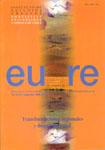Binational Metropolitan Areas in Mercosur
DOI:
https://doi.org/10.4067/S0250-71612000007800005Keywords:
regional and local development, regional economy, metropolitan areasAbstract
This article analyzes trade along the international commercial corridor linking Sí£o Paulo, Buenos Aires, and Santiago-Valparaíso. In the context of the megamarkets supported the most competitiveness microregions and their tendency toward growing trade within the economic bloc along with new intra-regional currents of external investment, the article demonstrates the marked industrial profile of that trade. The dominance of intermediate and capital goods among these reciprocal imports shows that the economies within Mercosur complement each other in production. This situation is in line with the corridors high urbanization, and even more so with the key role of the metropolises in shaping the corridor. In conclusion, the article outlines the emergence of three binational metropolitan regions: that of Sí£o Paulo, Brasilian-Paraguayan; that of the River Plate, Argentine-Uruguayan; and the Interandine, Chilean-Argentine. These cross-border regions require regional action that is simultaneously sub-national and super-national, melding decentralization and globalization.Downloads
Published
How to Cite
Issue
Section
License
Copyright (c) 2000 Revista EURE - Revista de Estudios Urbano Regionales

This work is licensed under a Creative Commons Attribution 4.0 International License.
Al momento de aceptar la publicación de sus artículos, los autores deberán formalizar la cesión de derechos de autor a EURE, según las condiciones establecidas por la Revista.
Ésta establece que el autor autoriza a EURE de manera gratuita, exclusiva e ilimitada a reproducir, editar, publicar, distribuir, publicitar, comercializar y traducir el artículo, a cualquier soporte conocido o por conocer y desarrollar.
Del mismo modo, los autores aseguran que el artículo propuesto es original, no publicado y no propuesto para tal fin a otro medio de difusión.


